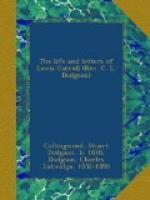On May 23, 1850, he matriculated at Christ Church, the venerable college which had numbered his father’s among other illustrious names. A letter from Dr. Jelf, one of the canons of Christ Church, to Archdeacon Dodgson, written when the former heard that his old friend’s son was coming up to “the House,” contains the following words: “I am sure I express the common feeling of all who remember you at Christ Church when I say that we shall rejoice to see a son of yours worthy to tread in your footsteps.”
Lewis Carroll came into residence on January 24, 1851. From that day to the hour of his death—a period of forty-seven years—he belonged to “the House,” never leaving it for any length of time, becoming almost a part of it. I, for one, can hardly imagine it without him.
Though technically “in residence,” he had not rooms of his own in College during his first term. The “House” was very full; and had it not been for one of the tutors, the Rev. J. Lew, kindly lending him one of his own rooms, he would have had to take lodgings in the town. The first set of rooms he occupied was in Peckwater Quadrangle, which is annually the scene of a great bonfire on Guy Fawkes’ Day, and, generally speaking, is not the best place for a reading man to live in.
In those days the undergraduates dining in hall were divided into “messes.” Each mess consisted of about half a dozen men, who had a table to themselves. Dinner was served at five, and very indifferently served, too; the dishes and plates were of pewter, and the joint was passed round, each man cutting off what he wanted for himself. In Mr. Dodgson’s mess were Philip Pusey, the late Rev. G. C. Woodhouse, and, among others, one who still lives in “Alice in Wonderland” as the “Hatter.”
Only a few days after term began, Mrs. Dodgson died suddenly at Croft. The shock was a terrible one to the whole family, and especially to her devoted husband. I have come across a delightful and most characteristic letter from Dr. Pusey—a letter full of the kindest and truest sympathy with the Archdeacon in his bereavement. The part of it which bears upon Mrs. Dodgson’s death I give in full:—




